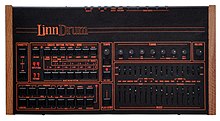LinnDrum
| LinnDrum | |
|---|---|

LinnDrum digital drum machine
|
|
| Manufacturer | Linn Electronics |
| Dates | 1982–1985 |
| Price | US $2,995 |
| Technical specifications | |
| Polyphony | polyphonic 12 voices |
| Timbrality | multitimbral 15 voices |
| Synthesis type | 8-bit digital samples, 28–35 kHz |
| Storage memory | 56 user patterns, 42 preset drum patterns, 49 songs |
| Effects | Individual level and pan for all sounds, tuning for snare, tom and conga only |
| Input/output | |
| Keyboard | 15 hard plastic "pads" |
| External control | pre MIDI, third-party MIDI Retrofit Kit, trigger inputs x5 |
The LinnDrum (often erroneously referred to as the Linn LM-2) is a drum machine manufactured by Linn Electronics as the successor to the Linn LM-1. It was introduced in 1982 at a list price of $2,995. About 5,000 units were sold between 1982 and 1985. The Linn 9000 was the successor of the LinnDrum.
Its high-quality samples, flexibility and affordability made the LinnDrum popular; it sold far more units than its predecessor (the LM-1) and its successor (the Linn 9000) combined.Roger Linn re-used the moniker on the LinnDrum Midistudio and the Roger Linn Designs' LinnDrum II. The LinnDrum was used on many recordings throughout the 1980s, including international hits such as a-Ha's "Take on Me" and Tears for Fears' "Shout".
When Linn Electronics closed in 1986, Forat Electronics purchased its remaining assets and offered service, sounds and modifications for the LinnDrum. The LinnDrum was pre MIDI, but Retrofit Kits were offered by JL Cooper and Forat Electronics.
The LinnDrum has fifteen 8 bit 28 kHz ~ 35 kHz digitally sampled drum sounds: bass drum, snare, side-stick snare, hi-hat, crash cymbal, ride cymbal, three tom-toms, cabasa, tambourine, high and low congas, cowbell, and hand-claps. Like the LM-1, it provided a sequencer for programming rhythm patterns, a built-in mixer and individual output jacks for each sound.
The LinnDrum improved on the LM-1 in many ways including: the addition of crash and ride cymbal samples, five external trigger inputs and the ability to replace built-in sounds with new sounds on EPROM chips. The LinnDrum sampled sounds from 28 to a 35 kHz sample rate. Also, the LinnDrum was $2,000 less than the LM-1.
...
Wikipedia
